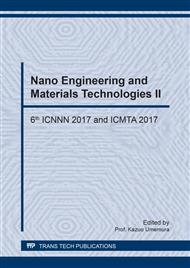p.207
p.212
p.217
p.221
p.226
p.232
p.239
p.244
p.249
AC Plus Deposition Method to Fabricate Array Ni Nanowires
Abstract:
The fabrication processes of nanomaterials adopt semiconductor manufacturing technology mostly, and restrain from mass production due to high vacuity, expensive equipment, and long cycle time. This research offers a relatively simple and convenient fabrication process to improve the manufacturing technology of nanowires. Starting with aluminum film of high purity, this research utilized anodizing to produce the array nanoporous mold, electrochemical deposition to inject ion-state metal, oxidation-reduction method to obtain metal nanowires, and annealing to result the oxidation of metal nanowires. The influence of substrate and oxidation layers was investigated with respect to parameters such as voltage, current, and time. In order to get the best control of array dispersion, diameters, and depth, the influence of temperature over the process is also investigated. A higher anodizing temperature was utilized to stabilize the fabrication process of the array nanoporous mold. The resulted metal nanowires were analyzed with X-ray diffraction, FE-SEM, and TEM, to inspect the morphology and crystallography. The observations are summarized. (a) The preferred orientation of nickel nanowires being annealed at the 600°C pure nitrogen is NiO(111). (b) As the oxidation temperature rises, NiO in pure oxygen or the atmosphere would transfer into Ni2O3 due to the size effect. Nickel nanowires in pure oxygen could oxidize into Ni2O3 at a lower temperature of 500°C. (c) Nickel nanowires both in pure oxygen and in the atmosphere would transfer stably into Ni2O3 at 900°C.
Info:
Periodical:
Pages:
249-253
Citation:
Online since:
March 2018
Authors:
Keywords:
Price:
Сopyright:
© 2018 Trans Tech Publications Ltd. All Rights Reserved
Share:
Citation:


